How Much Is a Dog Supposed to Eat?

Here is where you’ll find your furry friend's optimal nutrition. Let's navigate the intricacies of dog feeding, ensuring your pet receives the nourishment they need for a healthy, joy-filled life. Keep an eye on their weight, body condition, and health, and go to regular vet check-ups for tailored adjustments to their feeding plan as they age and grow.
General facts:
How, when, and what to feed your dog generally depends on your dog’s age, breed, size, body condition, and activity level
Treats should not make up more than 10% of your dog’s everyday diet
Most dogs will consume 2% to 4% of their body weight in food
How Much Food Should Dogs Eat: Nutritional Requirements
Raising a healthy canine requires daily nutrients that meet their bodies’ unique demands. It’s not only about how much food for a dog is needed, but also about its quality. To meet your furry friend’s requirements, you must ensure they get proteins, fats, carbs, and essential vitamins and minerals. Water is another indispensable part of their diet.
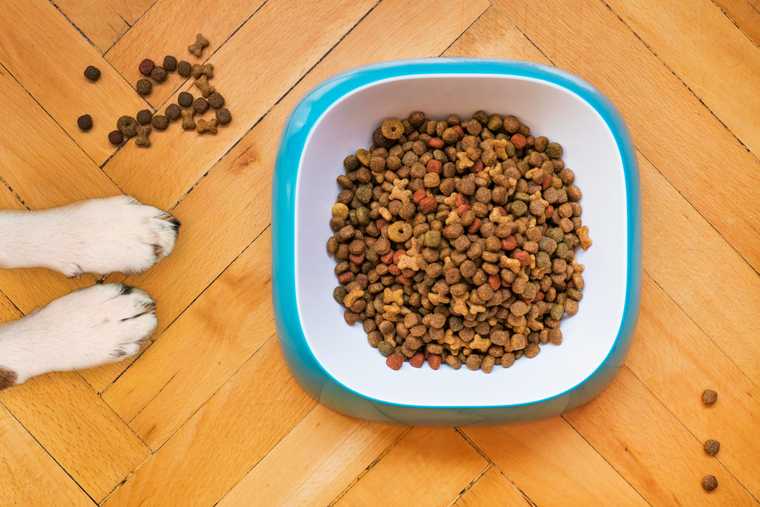
Proteins
To grow body tissue effectively, your dog needs 23 amino acids. While your pet can generate 13 of these independently, the other 10 must come from food. So, it’s an owner’s job to ensure a proper supply of proteins in the diet.
Fats
Being one of the primary energy sources, fats are essential for your dog’s health and well-being. They’re also responsible for good skin and fur. Give your pet adequate amounts of Omega-3, Omega-6, and Linoleic Acid daily.
Carbs
Another source of energy for your dog’s body is carbs. They also contribute to good gut health and proper digestion of food. Carbs mainly come from the grains and vegetables that your dog consumes.
Vitamins
Vitamins should come from your dog’s food, not supplements, unless your vet suggests explicitly otherwise. A balanced diet for a canine should include Vitamin A, D, E, K, Calcium, and Phosphorus from nutritious meals.
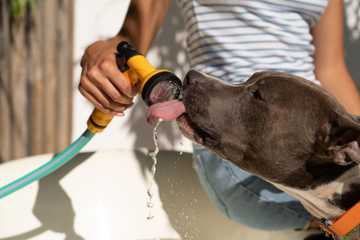
Water
Losing only 10% of the water in your dog’s body can have fatal consequences. Though wet pet food contains some liquid, it’s insufficient to meet the demand. That’s why you should ensure your pet has unlimited access to clean water to replenish their water deposits.
If you want to learn more about the nutritional requirements for small animals, including canines, consider checking the Association of American Feed Control Officials (AAFCO) guidelines.
This non-profit organization provides a comprehensive review of pet food and defines its ingredients. If pet food meets the AAFCO standards, you can be sure it provides a balanced mix of nutrients and essential vitamins.
How Much Food Should Dogs Eat?
Similar to humans, there is no universal diet that perfectly meets the needs of every individual. So, specific factors must be considered when selecting the ideal diet for our furry companions.
Age
Younger dogs have much faster metabolisms than older dogs (like humans), so it’s imperative to reduce your adult dog's food intake once they’ve stopped growing to prevent them from gaining body weight.
Younger dogs also require more protein and specific omega-fatty acids that help them grow.
Breed
Some breeds, especially working-type dogs, will metabolize more calories daily than others. Examples of this include the working cocker vs. show cocker spaniel. A working cocker will likely need a lot more food than a show line cocker if they’re receiving the same amount of exercise and are the same age!

Size
Larger dogs will burn more calories throughout the day than smaller dogs and thus require more food. That’s why the calorie intake for giant breeds, medium-sized dogs, and toy breeds will differ significantly. Responsible pet parents should consult a professional to properly develop their companion’s feeding chart.
Activity level
It’s a good idea to give less fatty foods to dogs that exercise less. If your dog’s lifestyle is sedentary, they will do well with a greater proportion of fiber in their diet, which helps keep them full without adding unnecessary calories.
Dog with allergies and/or sensitivities
Common dog allergies often involve poultry. If your dog has itchy skin, inconsistent stools, or otherwise odd behavior, try removing poultry from their diet and look for improvements over the next few months. Dogs can also be allergic to certain grains and starches. Remember, allergies may develop later in life, not necessarily from birth. If unsure, consult your vet and consider trying an elimination diet.
Pregnant dogs
Pregnant dogs require more food throughout their pregnancy, increasing until birth. Even after birth, the mother may need up to six times her usual calories while nursing puppies. Estimating how many calories she needs is crucial, as well as ensuring the mother gets the right balance of calcium and phosphorus to support healthy bones and milk production.
Neutered dogs
Neutered canines usually gain weight more easily due to slower metabolisms and thus require a lower-calorie diet than their intact counterparts.
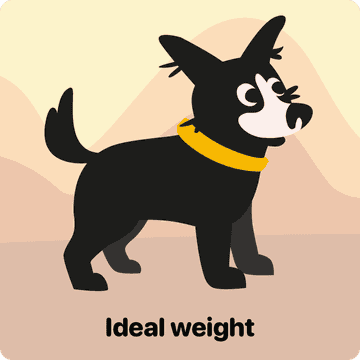
Female vs. male dogs
There’s no evidence to suggest that canines of different sexes require different food/calories, but the average male of the same breed is larger and thus will often require a slightly higher calorie intake.
Body condition
Maintaining an ideal body condition is vital for a dog's overall health. Regularly assessing their weight and adjusting their diet and how much food they consume ensures they get the right balance of nutrients without excess calories.
How Much Do Dogs Eat Depending on Age
Adult dogs
The amount depends on the canine's weight, activity level, and dietary needs. Most adult dogs do well with two meals a day, and the feeding guidelines on the dog food packaging provide a starting point.
Here's a sample dog feeding chart based on the caloric needs of adult dogs of different weights:
| Dog’s Weight | Calorie Intake Per Day |
|---|---|
| 3 pounds | 100 |
| 5 pounds | 148 |
| 10 pounds | 294 |
| 20 pounds | 418 |
| 30 pounds | 567 |
| 40 pounds | 703 |
| 50 pounds | 832 |
| 60 pounds | 953 |
| 70 pounds | 1070 |
| 80 pounds | 1183 |
| 90 pounds | 1292 |
| 100 pounds | 1399 |
P.S.: Remember that the information in this chart is very general; every dog needs an individual approach.

Puppies
Young puppies generally need more calories per pound of body weight to meet their nutritional needs than adult dogs. Follow the feeding guidelines on the puppy food packaging, adjusting based on your puppy's growth rate.
Senior dogs
Senior individuals often have reduced activity levels, so it’s vital to know how many calories they need daily and offer correct food portions to prevent excess weight gain. Adjust the portion size based on the specific senior dog food guidelines or vet recommendations.
How Often to Feed a Dog
Puppy
When raising a puppy, you should know how much food for a dog is needed per day and what frequency of meals is acceptable. Feed puppies four times daily, gradually transitioning to two meals as they mature. Offering puppy food more frequently accommodates their smaller stomachs and higher energy needs during growth.
| Puppy | Meals Per Day |
|---|---|
| Up to 12 pounds | 4 |
| Up to 40 pounds | 4 |
| Up to 75 pounds | 4 |
| Up to 100 pounds | 4 |
Adult dog
Most adult dogs thrive on two meals a day. Adjust portions based on weight, activity level, and specific dietary needs. Regular feeding schedules contribute to consistency and routine.
| Adult Dog | Meals Per Day |
|---|---|
| Up to 12 pounds | 2 |
| Up to 40 pounds | 2 |
| Up to 75 pounds | 2 |
| Up to 100 pounds | 2 |
Senior dog
Senior canines often benefit from two meals a day. Monitor their weight and adjust portions to accommodate reduced activity levels. Consider specialized senior dog food to address changing nutritional requirements.
| Senior Dog | Meals Per Day |
|---|---|
| Up to 12 pounds | 2 |
| Up to 40 pounds | 2 |
| Up to 75 pounds | 2 |
| Up to 100 pounds | 2 |
Why Does Dog Food Amount Matter?
Overfeeding
Overfeeding can lead to issues such as joint problems, as excess weight puts too much pressure on the joints during exercise. Other potential problems include diabetes, heart issues, skin problems, and even cancer. Overweight dogs have increased risks of health issues, so they must stay slim and fit to live a long and happy life!
How to fix overfeeding with slow feeders
Slow feeders, designed to slow down dogs' eating speed and regulate how much food they receive, offer several benefits. They help prevent issues like bloat and improve digestion. Slow feeders also support body weight management by encouraging dogs to eat more thoughtfully and preventing overeating.
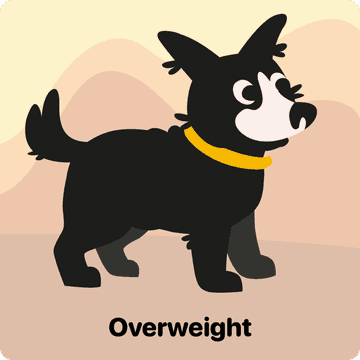
Beyond physical health, these feeders provide mental stimulation, making it a positive and engaging experience for dogs.
If your dog is crafty and flips their slow feeder bowl over, add water to the food and freeze it before giving it to your dog!

Underfeeding
Malnutrition and underfeeding can cause poor coat conditions and skin problems, such as flaky skin. Additionally, in extreme cases, consistent failure to meet their nutritional needs can lead to organ damage and, eventually, failure.
What to Consider When Choosing the Right Food?
How to choose the proper kibble for your dog: Avoid any type of meal (for instance: meat meal, poultry meal, corn gluten meal), menadione, peanut hulls, dyes and colors, poultry or animal digest, animal fat, propylene glycol, soybean oil, soy flour, ground soybeans, soybean meal, soybean hulls, oxide or sulfate forms of minerals (for instance: zinc oxide, titanium oxide, copper sulfate), poultry or beef by-products, BHA, BHT, ethoxyquin, and sodium selenite.
You should look for real and non-adulterated ingredients, such as beef, chicken, beef liver, turkey, salmon, organic green beans, and blueberries.

Although the best food you can give to your dog is raw, unprocessed, unadulterated food, you can choose the best kibble for your dog and add a few healthy toppers/treats (e.g., spinach, cucumbers, broccoli, blackberries, blueberries, sardines, and organ meats) that will optimize your dog's diet and reduce inflammation, remove toxins from their body and have many other benefits for your dog's health.
Is Dry or Canned Food Better?
Though the question seems straightforward, it’s not easy to answer. The ultimate choice will depend on the pet owners’ feeding philosophy, convenience, and financial opportunities. Each feeding option has specific advantages to consider.
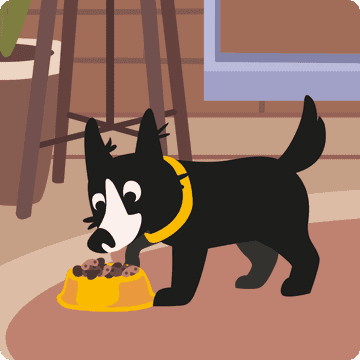
Dry dog food contributes to oral health by reducing plaque and providing plenty of chewing opportunities. This can also serve as a stress relief. It's also more convenient to use if you plan to travel with your pet, as it doesn’t require refrigerator storage. Finally, dry food is more economical and still provides the needed nutrients.
Canned food is best for picky dogs, as it’s more appetizing and digestible. It’s also an excellent choice for pets with health issues. The high amount of water in wet food can also provide canines with extra opportunities for hydration.
However, this type of food has disadvantages, such as higher cost and a short shelf life. After opening, it should always be kept in the refrigerator. In addition, canned food can contribute to dental hygiene problems, as it’s difficult to remove from canine teeth.
Though some experts believe wet food is a healthier option, kibble is still a good choice that meets your pet’s nutritional needs. It can be more practical and affordable in certain circumstances. Regardless of the type you choose, if you feed your dog quality food, you can be sure your companion stays as healthy as possible.
Slow Feeders
Slow feeders, designed to slow the eating speed, offer several benefits. They help prevent issues like bloat and improve digestion. Slow feeders also support weight management by encouraging dogs to eat more thoughtfully and preventing overeating.
Beyond physical health, these feeders provide mental stimulation, making it a positive and engaging experience for dogs.
If your dog is crafty and flips their slow feeder bowl over, add water to the food and freeze it before giving it to your dog!
Wrap Up
In conclusion, determining the proper diet and how much your dog needs to eat is crucial for their overall well-being. Tailoring their nutrition to specific life stages is essential for playful puppies, active adults, and senior companions. Regular veterinary consultations and diligent monitoring ensure a customized feeding approach that contributes to your furry friend's happy and healthy life.

Passionate team dedicated to help pet owners raise safe and obedient dogs, fostering meaningful connections with their furry companions.

Experienced dog trainer with Bachelor of Science Degree in Animal Behavior. Diplomaed dog nutritionist. CFBA Accredited Canine Behaviorist